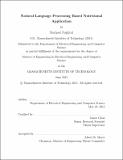| dc.contributor.advisor | James Glass. | en_US |
| dc.contributor.author | Naphtal, Rachael (Rachael M.) | en_US |
| dc.contributor.other | Massachusetts Institute of Technology. Department of Electrical Engineering and Computer Science. | en_US |
| dc.date.accessioned | 2016-01-04T20:01:16Z | |
| dc.date.available | 2016-01-04T20:01:16Z | |
| dc.date.copyright | 2015 | en_US |
| dc.date.issued | 2015 | en_US |
| dc.identifier.uri | http://hdl.handle.net/1721.1/100640 | |
| dc.description | Thesis: M. Eng., Massachusetts Institute of Technology, Department of Electrical Engineering and Computer Science, 2015. | en_US |
| dc.description | This electronic version was submitted by the student author. The certified thesis is available in the Institute Archives and Special Collections. | en_US |
| dc.description | Cataloged from student-submitted PDF version of thesis. | en_US |
| dc.description | Includes bibliographical references (pages 67-68). | en_US |
| dc.description.abstract | The ability to accurately and eciently track nutritional intake is a powerful tool in combating obesity and other food related diseases. Currently, many methods used for this task are time consuming or easily abandoned; however, a natural language based application that converts spoken text to nutritional information could be a convenient and eective solution. This thesis describes the creation of an application that translates spoken food diaries into nutritional database entries. It explores dierent methods for solving the problem of converting brands, descriptions and food item names into entries in nutritional databases. Specifically, we constructed a cache of over 4,000 food items, and also created a variety of methods to allow refinement of database mappings. We also explored methods of dealing with ambiguous quantity descriptions and the mapping of spoken quantity values to numerical units. When assessed by 500 users entering their daily meals on Amazon Mechanical Turk, the system was able to map 83.8% of the correctly interpreted spoken food items to relevant nutritional database entries. It was also able to nd a logical quantity for 92.2% of the correct food entries. Overall, this system shows a signicant step towards the intelligent conversion of spoken food diaries to actual nutritional feedback. | en_US |
| dc.description.statementofresponsibility | by Rachael Naphtal. | en_US |
| dc.format.extent | 68 pages | en_US |
| dc.language.iso | eng | en_US |
| dc.publisher | Massachusetts Institute of Technology | en_US |
| dc.rights | M.I.T. theses are protected by copyright. They may be viewed from this source for any purpose, but reproduction or distribution in any format is prohibited without written permission. See provided URL for inquiries about permission. | en_US |
| dc.rights.uri | http://dspace.mit.edu/handle/1721.1/7582 | en_US |
| dc.subject | Electrical Engineering and Computer Science. | en_US |
| dc.title | Natural language processing based nutritional application | en_US |
| dc.type | Thesis | en_US |
| dc.description.degree | M. Eng. | en_US |
| dc.contributor.department | Massachusetts Institute of Technology. Department of Electrical Engineering and Computer Science | |
| dc.identifier.oclc | 933235536 | en_US |
